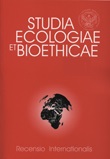Competition for food in macroplankton animals in the Vistula Lagoon
Competition for food in macroplankton animals in the Vistula Lagoon
Author(s): Krzysztof W. OpalińskiSubject(s): Geography, Regional studies, Environmental Geography
Published by: Wydawnictwo Naukowe Uniwersytetu Kardynała Stefana Wyszyńskiego w Warszawie
Keywords: interspecific competition; early developmental stages of fish species; Vistula Lagoon
Summary/Abstract: Competition for food can be observed in the macroplankton community in the Vistula Lagoon (northern Poland) in the spring (April-May-June). This is the time of mass occurrence of early developmental stages of the Baltic Sea herring, the European smelt perch, and stickleback. Additionally, some quantities of the shrimp Neomysis integer can be found. These species use the same food resources, i.e. small zooplankton, but they occupy different habitats. However, in a very special situation in the Vistula Lagoon (low depth and water mixing by winds) they are living together and compete for food. The purpose of this paper is to find out which species is the superior competitor for food among the macroplankton living in the Vistula Lagoon. Animal size (dry weight Dw), daily consumption rate (C), and coefficients of food assimilation efficiency (U-1), as well as utilization of consumed energy for growth (K1), and utilization of assimilated energy for growth (K2) by individuals of particular species were used as measures of individual success in competition for food. Animal abundance (n m-3), daily consumption rate of individuals of particular species living in the unit of water volume (J m-3 d-1), and total food consumed by animals of particular species living in the unit of water volume as a percent of the total food available were used as measures of population (or species) success in competition for food. The re¬sults do not provide a clear indication which species is a superior competitor for food. Because competition occurs at the level of individuals rather than populations, a question arises why just Neomysis, despite their lowest food consumption and the lowest daily production rate succeeded in reaching high population numbers and sum of daily food consumption by population.
Journal: Studia Ecologiae et Bioethicae
- Issue Year: 12/2014
- Issue No: 4
- Page Range: 127-148
- Page Count: 22
- Language: English

